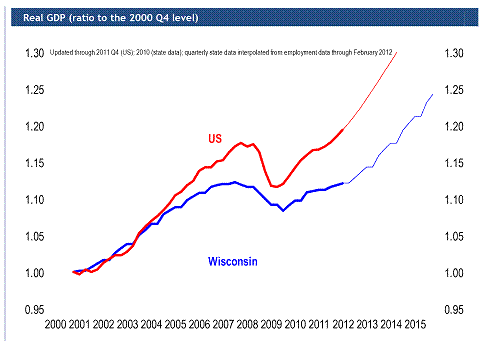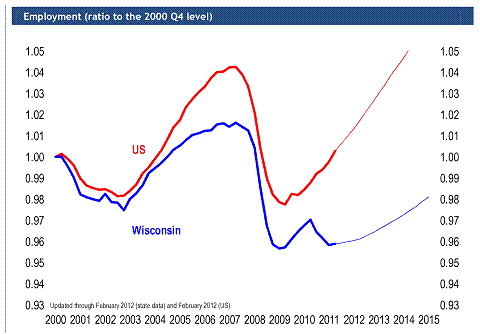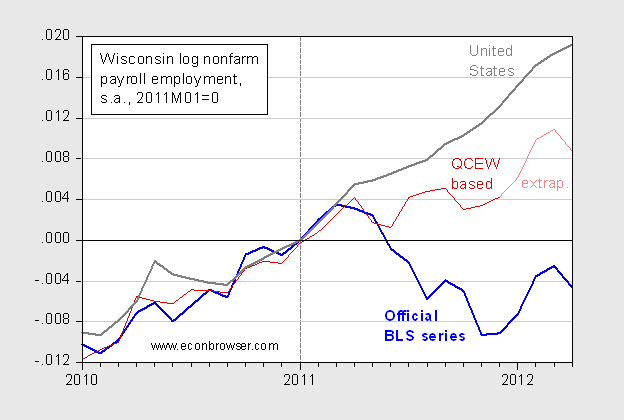The Spring Wisconsin Economic Outlook has not yet been released (last year, I believe it was released in early/mid May), so I thought I’d take a look at what recent private sector forecasts indicated. Here is one graph of relative GDP trends from Chase’s State of the Wisconsin Economy, dated March 31.

Figure from Chase, The State of the Wisconsin Economy, March 31, 2012.
Note the trend break at beginning of 2011. The forecast for employment growth is also of interest.

Figure from Chase, The State of the Wisconsin Economy, March 31, 2012.
Even after adjusting for anticipated re-benchmarking of the WI NFP series associated with QCEW data (discussed here), employment trends are not particularly auspicious relative to nationwide trends. This point is highlighted in Figure 1.

Figure 1:Official BLS Wisconsin log nonfarm payroll employment series (blue), US log nonfarm payroll employment series (gray), and QCEW-based estimates of NFP, see text (red), and spliced BLS series from Jan-Apr (salmon), all normalized to 0 at 2011M01. Dashed line at 2011M01. Source: BLS (April release), BLS (April release) via FRED, author’s calculations.
Note that the new fiscal year starts on July 1, so much of the momentum in the first part of CY2011 is associated with the prior administration’s budget.)
Given slated decreases in government spending in CY2012 (the average of FY2012 and FY2013 levels) expressed as a share of state GDP or in real per capita terms, these extremely modest income and employment gains (in absolute, and expressed relative to nationwide terms) seem plausible.
Speaking of counterproductive pro-cyclical macroeconomic policies, I will be speaking at the Center for American Progress on June 14th, where the topic of the panel will be “Assessing the Austerity Experiment”. The panelists include Carlos Mulas-Grenados (Executive Director, IDEAS Foundation, Spain), Jared Bernstein (Senior Fellow, Center on Budget and Policy Priorities; former Chief Economist and Economic Adviser to Vice President Joseph Biden), and Zach Schiller (Research Director, Policy Matters Ohio). The keynote speech will be given by Mass. Governor Patrick Deval.
Mission acomplished! Next up: destroy the unions of the evil Fire and Police, and eliminate all private sector Wisconsn unions. If dirty lib feminazis try to stop us, we’ll just bury them 8 to 1 under Wall Street money once again.
Soon Wisconsin will be another Texas or Mississippi!
You go Menzie! A real liberal love fest there at CAP……about as fair and balanced as MSNBC! Can we remember this the next time you p and m about Fox news?
Robert: I don’t recall ever having stated anything negative about FoxNews. I have even been quoted by FoxNews. Please identify the instance where I have.
I tried to explain this new paradigm to 2slugs but he/she is hopelessly lost in the past. We are up against a public spending constraint. The tradeoff is no longer public vs private. The tradeoffs are within the public sector. For example, an increase in spending on public pensions = a decrease in the number of teachers hired.
To his credit, Scott Walker has figured out a solution to the problem.
Here are a couple of excerpts from an article in the Wall Street Journal – June 7, 2012. Scott Walker’s Education Victory Union reforms have freed more money for classrooms in Wisconsin. And not only in Wisconsin.
It’s resonating because taxpayers see it working. In addition to limiting collective bargaining, the Walker reforms let schools competitively bid on health insurance, asked employees to contribute to health and pension plans, and introduced merit pay. The Legislative Fiscal Bureau estimates the pension provision alone will save schools $600 million over two years, while competitive health bidding is already saving $220 per student per year.
Places like the New Berlin school district, with its 4,700 students, have already reduced health-care costs by $2.3 million, retirement costs by $1.25 million, and other liabilities by $15 million. The district hired new staff, reduced class sizes, and added programs. The Shorewood district saved $537,000 simply by bidding out its health contract (previously run by a union outfit), and also reduced insurance premiums for its teachers.
Parents are also seeing the alternative via liberal school districts that rushed to lock in contracts prior to the reforms. Among them were the Milwaukee, Kenosha and Janesville districts, which this year reported the largest number of teacher layoffs in the state. Those districts accounted for 40% of the state’s teacher firings, though they educate only 12.8% of Wisconsin kids.
…
Democrats are resisting, but they helped set the stage. By 2010, states were already on a fiscal cliff when the sudden evaporation of President Obama’s stimulus handouts turned emergencies into catastrophes. This gave reform-minded governors the opening to argue that big change was a prerequisite to continued dollars for schools.
This has been a quiet revolution, masked by the broader fight over public unions, but it is big, and growing. Self-government is good for many reasons. Mr. Walker has helped show that top among those reasons are kids.
I love the limitless uptrends that always start next quarter.
You know, in MA the state, run by Democrats, has accomplished essentially the same list of things trumpeted by the GOP in places like WI but without the drama. Towns, for example, have been moving into state run pools for pension and insurance.
Every state and locale faces issues of employees benefit costs. My town noticed this a dozen years ago. It’s largely a consequence of arithmetic: defined benefit plans were designed in an era when average pay was much lower and, with inflation over decades, the nominal pay amounts have risen substantially. This isn’t a Democrat or Republican issue. Collective bargaining is, but employee costs are not.
Note that states run by the GOP have the same or worse issues. SC, that bastion of conservatism, has perhaps the riskiest pension fund – underfunded by a huge amount per capita. That shows the other side of the coin: capture by big money interests, meaning Wall Street pulled these conservative GOP legislators into doing the same stupid things everyone points at as bad. Money pulls one way and unions pull the other. The unions want security, not speculation and the big money wants speculation, not security.
Have you tried controlling for industries?
I hear there’s not a lot of shale gas in Wisconsin.
I can tell you the conclusion of the CAP conference already: 8% GDP deficits are not big enough, and we need way more Solyndra-style central planning.
According to Milwaukee Manpower Inc, 26 % of surveyed Wisconsin companies plan to add workers from July through Sept, whild only 5% expect layoffs.
More details here.
http://wtaq.com/news/articles/2012/jun/12/report-more-wisconsin-companies-hiring/
Now I’ll just sit back watch Dr. Chinn explain this away. Of course, I’ll reference this exact post in the next few months as we see how his analysis plays out.
There has been an effort by many to convince the public that the Scott Walker administration in Wisconsin has made huge cuts to public employee compensation. This study shows that even after requiring public employees to assume some of the responsibility of their own benefit compensation, Wisconsin public employees are still compensated much more than market based compensation.
• After Act 10, Wisconsin state workers receive health benefits nearly twice as valuable and pension benefits more than 4.5 times as valuable as what workers in large private firms receive.
• Before Act 10, Wisconsin state employees received total compensation (salary and benefits) about 29 percent higher than comparable private sector workers. After Act 10, the compensation premium is about 22 percent.
• In dollar terms, the average Wisconsin state worker after Act 10 receives total compensation including benefits equal to $81,637 versus $67,068 for a similarly-skilled private worker, a difference of $14,569.
The changes passed by the Walker administration have not even been in effect for a full year but pundits are already attempting to discredit them by using unemployment numbers that actually are based on the past administration policies. The changes that have been made have allowed school districts to balance budgets and are healing the Wisconsin budget hemorage, but still Wisconsin public employees receive more of Wisconsin taxpayer revenue than market analysis would justify.
But with the healing that has come to Wisconsin’s fiscal condition since the compensation reforms, there can be little doubt that the healing of Wisconsin employment will soon follow.
The People of WI have moved past the rhetoric of the “Progressives” and the lies of there political slaves. Make sure you keep a copy of the projections, Menzie. They are not accurate. Now that that the destructive elements of the social fabric of WI have been beaten back, business will have a stable platform and reliable work force. Watch for WI to become one of the fastest growing states in the midwest by 2014,
Steve,
I don’t those projections can hold a candle to this one: Deficit less than 3% of GDP in 2013.
Oops. Let’s try that again.
I don’t think those projections can hold a candle to this one: Deficit less than 3% of GDP in 2013.